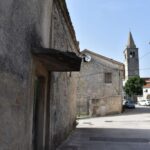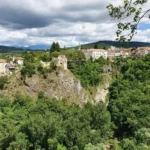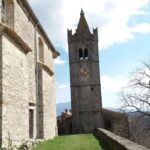Set in central Istria, Oprtalj rests on a 378-metre hill, surrounded by vineyards, olive groves, and the soft embrace of open skies. As you approach, the scent of olives drifts through the air and the rhythm of the vineyards seems to slow your steps. From the hilltop, views unfold gently, revealing valleys and horizons that stretch without haste. Picturesque and compact, Oprtalj is a place where time lingers — in the stone walls, in the quiet streets, and in the calm of the landscape that wraps around it.
When I first arrived in Oprtalj, what I first noticed was the beautiful view, extending to the Istrian green landscapes. As I got closer and closer to the old town after the entrance through the city gates across the city loggia, I soon realized that this place, the jewel of central Istria, is worth a visit. Oprtalj, first mentioned in 1102 as Castrum Portulense in Histria, developed on the site of a former prehistoric fortress during the Illyrian period. From that time until today it has developed into a small town filled with picturesque house architecture.
The eponymous name ” Portole ” seems to be formed not only because of the inherited approximate name ( Castrum Portulense ) but also because Oprtalj once had three city gates (porta-gate). The name possible also comes from the adjective “open” = to open, which later grows into the name of the city. Walking through Oprtalj is a wonderful experience. Providing one of the best images of small networked streets, Oprtalj is one of those remaining towns of symbols of true, authentic Istria
Things to do in Oprtalj
Spending time walking through Oprtalj means indulging in the time of the past and art. Unlike some other towns that can be seen from the right valley of the Mirna, such as Grožnjan, Kostanjica or Završje, Oprtalj remains hidden. Built on a hill to be safe from invaders the once medieval city was surrounded by polygonal-shaped walls.
Walk alongside the streets with the spirit of the past
Today, the small town provides a real art experience. Small picturesque houses, alleys and city walls spread the atmosphere of some forgotten times. And to better understand such an atmosphere, it is necessary to simply stop, observe, and listen. Oprtalj offers a lot in the authentic sense of the past. Istrian Marquis Ulrich II. He donated it with his estates to the Church of Aquileia.
Although unlike neighbouring Motovun, the medieval walls of Oprtalj are barely visible today and are mostly built into houses, they testify to the defensive purpose of what they had in the Middle Ages. Oprtalj was a very important fortress for the Romans and Venetians. In the territorial distribution of Venetian possessions, the latter marked it as ” Castello minore “, ie a smaller fortified town. It is necessary to walk through this fortified town, through narrow streets where they are usually without cars, but that is what makes it, like other small towns in central Istria, special, right?
Take a look at the sights of the mystical Middle Ages
Oprtalj is one of those towns that will reveal to us medieval monuments in the true sense of the word. Even before entering the city, opposite the city gates, there is a magnificent, recently restored city lodge from the 16th century. It may be one of the most beautiful Istrian houses with lapidary. Until the departure of Venice, it served as a local court, and today it serves as a lapidary of Roman, and medieval monuments. The beautiful lion of St. The brand is a typical symbol of the time of construction.
Admire the Oprtalj churches with frescoes
Frescoes as an indispensable element of churches in Istria can be found in many in the vicinity of Oprtalj. At the foot of Oprtalj, at the western entrance, along the road to Sv. Lucija, ie Zrenj, Šterna and Buje, in the shade of cypresses, is the church of St. Mary of 1479. The single-nave basilica, built as a fraternal church with a bell tower and a tomb (1770), is decorated with frescoes from different periods. Paintings on the triumphal arch and the south wall from 1471, in the Renaissance style, are attributed to the master Clerigine of Koper. Frescoes by authors depicting non-Mediterranean, northern influences are also visible. The cycle of frescoes consisting of 24 scenes is attributed to the Colorful Master.
On a hill outside the city, we will come across the church of St. Helen dating back to the 15th century. Inside there are Glagolitic graffiti from 1496 and frescoes by Clerigine of Koper, the same master who painted the frescoes in the church of St. Mary. Church of St. Roca, at the southern entrance from 1581, in addition to being built as part of the protection against the plague, contains a series of frescoes. It was painted by master Anton Padovski in 1535.
Parish Church of St. George in the central town square from 1526 has a colourful facade. It is characterized by Gothic ribs and a presbytery, and the interior preserves 18th-century paintings, statues and organs. Opposite the church is a bell tower, 27 meters high. It was completed in 1740 and today is a picturesque symbol of the place.
Enjoy unforgettable views
Located on a hill 378 meters above sea level, Oprtalj will provide beautiful views. The views of the green landscapes of central Istria, along with the peace and uniqueness of a typical rural place, are one of my favourite reasons to return to Oprtalj. And they are perhaps the most beautiful from the terrace next to the town lodge. In nice weather, when the view reaches almost Trieste it seems as if we can touch the sea in the palm of our hand.
A special mark is overlooking the neighbouring peak, where the town of Motovun is located. But the view of the landscape that reveals Istrian charm will not always be the same. On the contrary, it is certainly different and special according to the season. In autumn, the vineyards will spread their yellow colour, and in summer the surroundings will give the impression of a green oasis. Still, we will always meet a cat that rests carefree on the wall.
Spend the day in art
Tiny picturesque houses, little streets and town walls make wide the spirit of some forgotten times. Stay here and listen to this hill’s tranquillity, but don’t fail to notice its historical sounds. Take your camera and shoot beautiful landscapes around the place, vineyards, plants, and the cat in the street.
Like all the other middle Istria places, here is a unique charm at every time of the year. However, don’t hesitate to visit it in autumn when the beautiful vineyards are spreading their fruits… Oprtalj is also attractive from his lowlands. Leave your car, take a walk, try the Istrian vine, truffle, make the photography, remember and share the experience.
Oprtalj events
The truffle Days are with no doubt, the most famous event that is held in oprtalj
“Truffle Days fair”
Every year in October has been held here a fair “Truffle days”. It is possible to taste and buy excellent Istrian products like olive oil, cheeses, wines, honey, and the brandy expire what a real Istrian fair looks like. So, if you are a fan of gastronomy, you should not miss it. An expert jury values the truffles as they can be bought at a public auction. The truffle hunt is organized with the train dogs.
Nowadays the truffle is a specific delicatessens standard feature on each restaurant’s menu or rural estates in Istria. However, it is in a more wide region, Slovenia, Italy. The Livade has become known as a centre of the truffle world hosting the only significant fair of its type in Croatia. Did you know that in November 1999 nearby Livade was founded the most giant truffle in the world to date (1.31 kg), and it was recorded in the Guinness Book of Records?
Chestnut Festival
Suppose you are in central Istria in October. In that case, you can not miss the Chestnut Festival, which is also the only one of its kind organized in Istria. Get to spend the autumn afternoon with the gastronomic pleasure of the fall in Oprtalj. Among the delicacies, roasted chestnuts are offered and the various dishes are prepared from this salty autumn fruit and homemade chestnut honey. Besides, you can enjoy cheerful music, and dancing. Simultaneously, the young wines popular called “Mosht” made by the local winemakers wouldn’t be missed.
Antiques Fair
It is an event that takes place on the second Sunday of each month. At the fair, you can meet collectors and traders of antiques from all over Croatia and abroad. The antique products are exhibited on the streets, in small retail spaces on the ground floors of buildings and the city loggia.
Alpe Adria Oberkrainer Fest
The festival, which hosts folklore orchestras from Italy, Slovenia, Austria and Croatia is a unique regional event. It attracts performers from different regions, connected by cultivating the same musical expression.
Simultaneously, at the fair, which presents producers with characteristic products of this region, such as wine, olive oil, and honey visitors also have the opportunity to taste the black summer truffle.
How to tour Oprtalj surround
There are plenty of choices.
Truffles tasting in Livade
You simply can’t be in Istria and not eat (over and over again) truffles. Istrian truffles are the first class you need to taste, and Livade is the right place you can do it. Livade is a valley place, situated on the north edge of the Mirna River. There are two hilltop places, Oprtalj and Motovun surrounding it. One of the most used ways to visit Oprtalj and Motovun is through this little village Livade. Livade like the other towns in the surroundings belongs to the mediaeval places of the middle Istria peaks.
The place got its nickname from the surroundings of Mirna River valley near the Motovun Forest. Because of its position where Livade has been developed in the heart of Istria, the place became a trade centre of the wine trade, olive oil and agricultural products. Today is considered “the truffle centre of the world”. The white truffle was first founded nearby Motovun in the Mirna valley in the 1920-s. Since that time, Livade has held the status of a well-known world centre reigned by its majesty – the truffle. Sol let’s try one of the truffles.
Jump On Two Wheels across the Parenzana
The railway track museum Parenzana could be visited in Livade, while the place was built near it. The “Parenzana” was once a mainly narrow-gauge railroad connection between Poreč and Trieste via Buje, Grožnjan, Oprtalj and Vižinada. It’s assumed that cargo was transported by river barges until the railway was built. It was completed in 1902 and was built on the Austrian initiative.
Today is the route served as a bicycle track and walking path. Let’s meet the Parenzana, which passed over the two bridges, six viaducts and trough eight tunnels on 122 km long tracks. Although the last train was passed the Parenzana in 1935, it enabled the development of the lowest parts of Istria, which were almost cut off from the world. The railway was served for the transport of people and agricultural produce. Nowadays route serves as a tourist attraction. Except for the bicycles, there is available sightseeing with the touristic train on Parenzana.
While you’re visiting middle Istria, there will be a good idea to make a bicycle drive across the Parenzana. Follow the tracks of giants and continue your visit further to Završje, Grožnjan, and Šterna.
Head to Čepić village next to Oprtalj
Nearby Oprtalj at about 400m above sea level is situated village of Čepić/Ceppi. An attractive architectural structure and typical Istrian houses are characterized by the Čepić. The small graveyard could be seen at the highest point of the village. There is the Church of the Holy Trinity on it, which dates back to the 17th century.
All the lovers of climbing will get fun here. The attractive natural rocks with several easy climbing routes could be found nearby the village of Čepić situated northwest of Oprtalj. The climbing routes are suitable for beginners in rock climbing. They provide a magnificent view of the green valley with rich flora and fauna, three drinking water springs and an immense abyss. Why not try some of it?
Visit Zrenj
Driving in the direction northwest of Oprtalj, after 10 kilometres is reached the beautiful place of Zrenj. So if you arrived in Zrenj, it means you are in the position of crafts. Zrenj was famous for its exceptional craftsman as blacksmiths, weaver’s potters and furniture makers. The roofs of the houses were covered by “Škrile”, which is typical Istrian architecture. Škrile once covered the most tops in Istria. Take a look at the view from Zrenj. Isn’t it beautiful?
The Parish Church of St George is situated in the centre of Zrenj. It’s a two aisle church with an altar and chapel of the saint. The church was built in Romantic style and was first mentioned in 1304. Later was extended in 1582. Glagolian signage which was found due to renovations in 1835 could be evidence of extension. It’s assumed that the church was under the Bishop of Trieste’s governance through the dean of Bizet till 1883. The marvellous and however separate bell tower is situated in the centre of that place. The bell tower is 36 meters high, and it was rebuilt in 1881 in the area of the last building, first mentioned in 1580. Take an image of Zrenj with a bell tower. It looks magnificent.
The church of St. Jeronimus is situated southwest of the village of Zrenj, next to the cemetery. It was built in 1910. It’s of single-aisle with an altar and a bell tower over the entrance. It is assumed that initially the old church was dedicated to St. Jeronimuswas located in the village itself.
Travelling To Oprtalj Istria, Croatia
- ✈️ By Air. Pula Airport is the best-connected airport in Istria and also the closest to Oprtalj, around 80 km away. Other convenient options with a similar travel time are Trieste, Rijeka, or Ljubljana (Brnik) airports. Larger international hubs include Zagreb and Ljubljana. If you land in Zagreb, count on about 240 km (roughly a 4-hour drive) to reach Oprtalj. Since there are no local bus lines directly to Oprtalj, the most practical way is by taxi or private transfer.
- 🚌 By bus. Public bus transport is well developed across Croatia and along the Istrian coast, but central Istria remains less connected. If you are lucky, you may catch one of the local buses running to Oprtalj, though services are infrequent and mostly tailored for locals. Choosing the bus means you’ll need a little spirit of adventure.
- 🚆 By train. The nearest train stations are in Buzet or Koper. From either, you will need a taxi or private transfer to Oprtalj (about 20 km from Buzet, longer from Koper). Because of this extra leg of the journey, the train is usually not the most practical option.
- 🚗 By car & parking. Although Oprtalj is a small hilltop town, its popularity grows each year. Several parking areas are available at the entrance, and the most convenient one is in front of the school. Keep in mind that cars are not allowed in the old town centre, so plan to leave your vehicle outside and enjoy the charm of exploring Oprtalj on foot.



